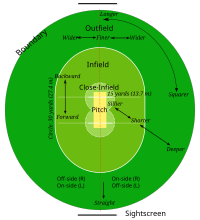Cricket field
A cricket field is a large, usually elliptical or round, lawn on which cricket is played. The use of artificial grass is rare.
Dimensions and Limitation
There are no provisions in the rules about the shape or size of the field. Typically, a cricket field is 450 to 500 feet in diameter . As a perimeter lying on the ground is regularly rope used, the Boundary Rope is called. The field boundary itself is called the boundary .
The pitch
Most of the game takes place in the middle of the cricket field on the pitch. This is a rectangular strip of firm clay soil with very short grass cover. It is 10 feet (3.05 m) wide and 66 feet (20.12 m) long. The wickets are on the two narrow sides . There are various lines on the pitch that are important for compliance with the rules in bowling ( no ball ) as well as in some ways of exiting the batsman .
Off side / on side
The playing field is divided into a left and a right half by an imaginary line running through the middle of the two wickets. From the perspective of the umpire at the bowler end of the pitch, when he looks in the direction of a right-handed striker at the other end of the pitch, the left half of the field is the off side, the right half the leg side, also known as the on side. With a left-handed striker, it's the other way around. The on (leg) side is always in the back of the batsman.
This classification is important both in connection with two rules (Law 36 and Law 41.5) and when naming many field positions and striking directions.
More markings
For games with a limited number of overs (e.g. one-day internationals ), two further lines are used in professional cricket, and sometimes also in the amateur area, which are important for the placement of the field players .
One line runs in a semicircle of 30 yards (27.4 m) around both wickets and continues in parallel lines to the opposite semicircle. It separates the inner field from the outer field. The second line marks the 15 yards (13.7 m) close range of each wicket.
The respective game rules determine, mostly for parts of the game, how many field players may or must line up in certain areas. These markings are not anchored in the actual Cricket Rules ( Laws of Cricket ).
Stadion
The grandstands usually start immediately behind the boundary. At least one scoreboard ( Scoreboard ) is always present. In well-known stadiums, the two narrow sides of the pitch and the various stands usually have special names.
The largest cricket stadiums in the world are on the Indian subcontinent and in Australia . Famous stadiums are:
- Lord's Cricket Ground , London, England
- Melbourne Cricket Ground , Melbourne, Australia
- The Oval , London, England
Individual evidence
- ↑ Definitions on the MCC website ( Memento of the original from March 7, 2009 in the Internet Archive ) Info: The archive link was inserted automatically and has not yet been checked. Please check the original and archive link according to the instructions and then remove this notice.


